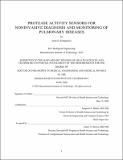Protease activity sensors for noninvasive diagnosis and monitoring of pulmonary diseases
Author(s)
Kirkpatrick, Jesse D.
Download1241253750-MIT.pdf (25.86Mb)
Other Contributors
Harvard--MIT Program in Health Sciences and Technology.
Advisor
Sangeeta N. Bhatia.
Terms of use
Metadata
Show full item recordAbstract
Effective disease management requires high quality and accurate information about disease state. As science and technology have evolved, the history and physical exam, once the foundations of the diagnostic workflow, have been supplemented with modalities that allow physicians to peer inside the body and acquire otherwise inaccessible information. To gain maximal information about a disease, a promising approach would be to administer a probe that can detect disease activity inside the body and emit a signal to the outside world. To this end, our group has developed "activity-based nanosensors", which detect dysregulated protease activity at the site of disease and release a reporter that can be measured in the urine. Because proteases are implicated in multiple diseases, including cancer, activity-based nanosensors have the potential to enable quantitative, noninvasive, and real-time monitoring of disease activity. Respiratory diseases are leading causes of death and disability, owing in large part to the constant exposure of the lungs to the external environment. Though this accessibility makes the lungs vulnerable to carcinogens and pathogens, it also provides a unique diagnostic opportunity. In this thesis, we aimed to optimize activity-based nanosensors for lung disease sensing in two settings: early detection and treatment response monitoring. Finally, we sought to establish a generalizable pipeline to rationally design such tools for human disease. We first delivered a multiplexed panel of sensors via intrapulmonary administration in two genetically engineered mouse models of lung adenocarcinoma. We found that our sensor panel diagnosed lung cancer in both models, detecting tumors as small as 2.8 mm³ without false positives from benign lung inflammation. We then evaluated this approach in monitoring treatment response in mouse models of malignant and benign pulmonary disease. We observed dramatic treatment-induced shifts in pulmonary protease activity in both models, enabling rapid, noninvasive, and quantitative evaluation of drug response. Finally, we established a suite of ex vivo assays that enabled the bottom-up design of a protease-activated diagnostic probe, opening the door for translation to human disease. Collectively, this thesis provides a framework for the clinical development of activity-based nanosensors for pulmonary disease diagnosis and monitoring.
Description
Thesis: Ph. D. in Medical Engineering and Medical Physics, Harvard-MIT Program in Health Sciences and Technology, May, 2020 Cataloged from student-submitted PDF version of thesis. Includes bibliographical references (pages 128-139).
Date issued
2020Department
Harvard University--MIT Division of Health Sciences and TechnologyPublisher
Massachusetts Institute of Technology
Keywords
Harvard--MIT Program in Health Sciences and Technology.